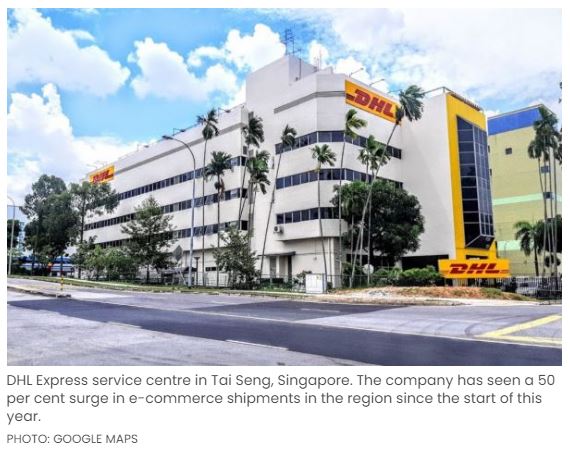DHL Express pumps 750m euros into Asia-Pacific amid e-commerce surge
DHL Express will invest some 690 million euros (S$1.1 billion) over the next two years to build new facilities or expand existing ones in its key growth markets of Australia, Japan, Hong Kong and South Korea.
It also plans to spend close to 60 million euros to bolster its Asia-Pacific air network, such as by introducing direct, new and frequent flight routes.
The express mail service provider expects this peak season – typically starting in November and lasting till Chinese New Year early in the following year – to see a 30-40 per cent surge in shipment volumes in the Asia-Pacific, compared to a year ago.
Its investments in the region are thus “crucial” in the near term as the company tackles an unusually strong peak season, said Ken Lee, chief executive of DHL Express Asia-Pacific.
The investments will also ensure the company is well positioned in the long run to keep global trade running as e-commerce and cross-border trade grow, he added.
According to DHL Express, the expanded infrastructure and new flight routes across the region will help the company address the growing demand for time-definite express deliveries.
Since the start of this year, the company has experienced a 50 per cent surge in e-commerce shipments in the Asia-Pacific, excluding China.
Its investments include a new 39.4 million-euro gateway facility in Malaysia, situated at the Kuala Lumpur International Airport. Scheduled for completion by 2022, this will be almost triple the size of the current facility and have more than triple the processing capacity.
In Bangladesh, DHL Express is investing around 25 million euros to build a new facility combining its country office and service centre into a 10,000 sq m site. It will increase shipment processing capacity by about 35 per cent and is expected to open in Q1 2022.
Construction of a new gateway facility in Bangalore, India is also underway, slated to be ready by next year.
Over in North Asia, it is pumping about 71.4 million euros into a distribution centre in Osaka, which is scheduled to open by the end of this year. Spanning 21,00 sq m of floor space, this will be DHL Express’ largest distribution facility in Japan. It will be equipped with a state-of-the art sorting system and X-ray inspection machines.
And its Hong Kong hub is undergoing a 377 million euro expansion that will boost warehouse space by half to 47,000 sq m and increase the hub’s annual throughput to 125,000 pieces per day.
There will be a planned investment of 131 million euros in a gateway facility in South Korea to more than double the shipment processing capacity. This expansion will almost triple the facility’s gross floor area to 58,700 sq m, making it the company’s biggest gateway in Asia-Pacific.
Meanwhile, two months ago in Australia, the company launched a 31 million euro service centre in Sydney, twice as big as the previous facility and equipped with an automated high-speed sorting system that processes up to 4,300 shipments per hour.
At its Brisbane gateway and service centre, DHL Express will spend some 13.2 million euros to increase the floor space and double the processing capacity. Operations will start by the end of next year.
New and expanded facilities are also being planned for Melbourne and Adelaide in the near future.
DHL Express said that it uses a new Boeing aircraft with a capacity of up to 102 tonnes to fly four times a week from its US hub in Cincinnati and the Los Angeles gateway to the hub in Singapore, via Sydney.
“The dedicated route shortens transit time for shipments to and from the US, and allows DHL to operate with greater efficiency while meeting the mounting demand for express deliveries,” it added.
The growth in e-commerce shipment volumes will continue to outpace the available air cargo capacity in the industry, said Sean Wall, executive vice-president of network operations and aviation at DHL Express Asia-Pacific.
This thus strengthens the case for the company to add new dedicated aircraft to its fleet, open up new routes, and supplement the fleet with charter flights, he added.
The coronavirus pandemic has taken a drastic toll on the air cargo industry. Despite the “overnight disappearance of commercial air belly cargo space”, the firm managed to keep its network fully operational, Mr Wall said.
Source: https://www.businesstimes.com.sg/asean-business/dhl-express-pumps-750m-euros-into-asia-pacific-amid-e-commerce-surge


 English
English




